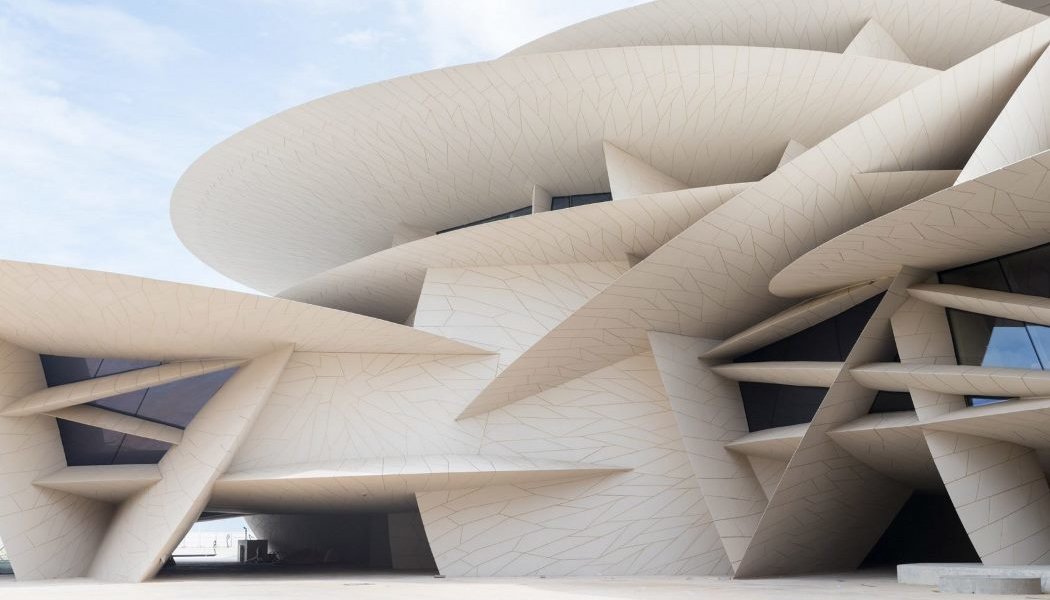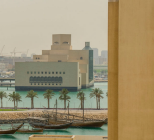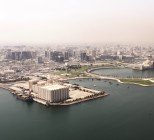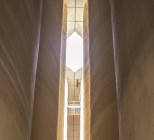Set along the coast in the Doha Port area of the city the new National Museum of Qatar is a dramatic building inspired by the desert rose – a mineral formation created when minerals crystallise below the surface of a salt basin into an array of flat plates resembling rose petals.
The building not only creates 40,000 sq m of new galleries and public spaces but also incorporates the restored historic Palace of Sheikh Abdullah bin Jassim Al Thani (1880-1957) son of the founder of modern Qatar: a building that in former times was both the home of the Royal Family and the seat of government, and was subsequently the site of the original National Museum. It is also surrounded by a 112,000 sq m landscaped park.
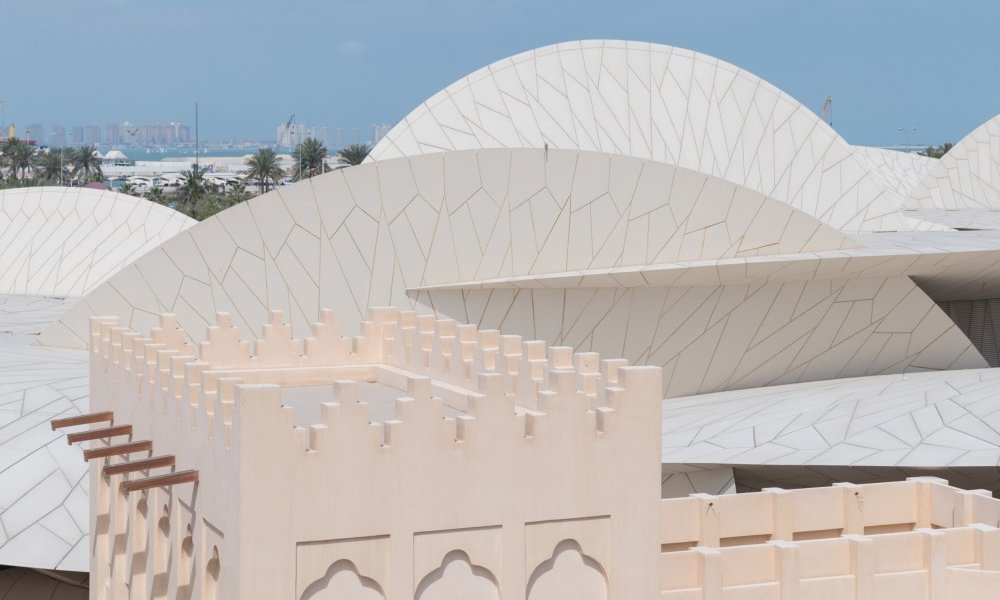
The National Museum of Qatar is organised in three chapters: Beginnings, Life in Qatar and Building the Nation. These chapters are presented in 11 galleries and the visitor is sent on chronological journey, which encompasses 2.7 km of experiences.
Sheikha Al Mayassa bint Hamad bin Khalifa Al Thani, Chairperson of Qatar Museums, established in 2005 to connect the museums, cultural institutions and heritage sites in the country and which has overseen the development of the new museum as well as the Museum of Islamic Art designed by IM Pei and Mathaf: Arab Museum of Modern Art, said culture connects people and the National Museum of Qatar supported the ambition to celebrate ‘our shared humanity’.
“Qatar is an ancient land, rich in the traditions of life in the desert and by the sea,” she said. “It is also a country whose modern history has been defined by oil, with all the dramatic change that its discovery brought. Today, as we enter a new era, Qatar’s trajectory onto the contemporary world stage has been just as rapid. Already we are in the vanguard of technological advance and are preparing, through the ambitious 2030 Qatar National Vision, an outward-facing, creative and sustainable future for all our people.”

Sheikha Al Mayassa said that in order to move the country forward they are focusing strongly on culture, in diverse forms, which means delving into its Arab heritage while also exploring the arts as they are evolving today.
In particular, she says, Qatar Museums is encouraging its own young artists, many of whom are women. “They are drawing on the unique perspective that their place in the global village allows them. At the same time they are looking to connect, ever more strongly, with their peers across the world, and in this we are supporting them.”
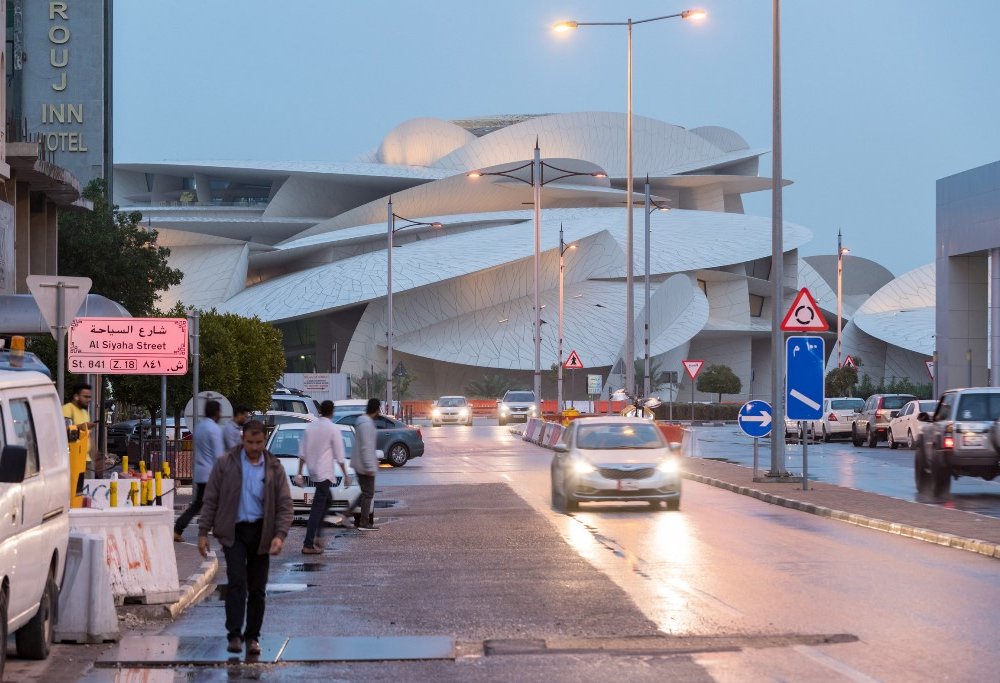
Artworks commissioned for NMoQ include a piece by Qatari artist Ali Hassan in the ground-floor public entrance, a work by Qatari artist and arts patron Sheikh Hassan bin Mohammed bin Ali Al Thani at the entrance to the galleries, and a sculpture by Iraqi artist Ahmed Al Bahrani in the outdoor space known as the Howsh, or caravanserai. Commissioned artworks in the NMoQ park include a monumental installation by the French artist Jean-Michel Othoniel comprising 114 individual fountains set within the lagoon, with their streams designed to evoke the fluid forms of Arabic calligraphy, and a sculpture by the Syrian artist Simone Fattal, Gates of the Sea, which evokes the petroglyphs found in Qatar at Al Jassasiya.
Qatar Museums said it seeks to push the boundaries of the traditional museum model and Sheikha Amna bint Abdulaziz bin Jassim Al Thani, Director of the National Museum of Qatar, said the National Museum will give visitors an unprecedented museum experience, with people at the heart of its vision and development.

“This is a museum that narrates the story of the people of Qatar and shares this story in an innovative, holistic, and immersive way. Central to the vision of the Museum is intergenerational learning, for school children, for adults, for all, through our multi-layered thematic exhibits, interactivity and programming. At the core of the museum’s permanent exhibits and accessible to the public is a digital archive of thousands of images, videos, and documents from Qatar and abroad. And all these elements will be made accessible to as many people as possible.”
The museum showcases oral histories, archival images and music and evocative aromas to create a sensory as well as immersive experience. One of the highlights of the collection on display is the Pearl Carpet of Baroda, commissioned in 1865 and embroidered with more than 1.5 million of the highest quality Gulf pearls and adorned with emeralds, diamonds and sapphires.
The Museum Journey - Sheikha Amna bint Abdulaziz bin Jassim Al Thani, Director of the National Museum of Qatar
Qatar Museums and the National Museum team felt strongly that we wanted to create a living experience for our people—a museum with a heart. That meant, first of all, that our galleries should be full of movement, sound, colour, and a sense of discovery. We believed we had the potential to go beyond even the most exciting existing museum displays and develop something truly immersive. And we believed the substance of those experiences ought to come from the Qatari people themselves. So we began a decade of planning and organizing.
Engaging displays
To develop our ideas about the form that our exhibitions might take, we visited institutions throughout the world, surveying the most advanced, engaging displays of history, natural history, and art. To develop the content of NMoQ, we began to organise meetings with the public, inviting Qataris to share whatever stories and materials they might care to offer. We asked them to tell us what they most wanted to see and hear in NMoQ. We held more than a dozen of these meetings, which were attended by more than 400 people. Out of them came a richness of information—of life—that became the essence of NMoQ.
Our next step was to distill this essence into themes that would run through the museum. We imagined the special combination of space, sights, sounds, and materials that would carry our visitors along—including the artworks and films we could commission to help tell our story.
Scholarly insights
At the same time, we were gathering scholarly insights and information from our local and international network of subject specialists. The depth of knowledge from these partners helped us shape the adventure in museum-going that was beginning to emerge.
To test our ideas, one of our earliest initiatives was to organize a pilot project, telling the story of the historic Palace of Sheikh Abdullah: the former home of the ruler and seat of government, and the original site of the National Museum. To discover how our themes and methods would resonate with people, we presented a three-month-long exhibition about the Palace. When 11,000 people came to visit and told us how much it meant to them, we knew we were on the right path.
Qatari people
Working hand-in-hand with our outstanding design team, we continued to give the new NMoQ its astonishing reality. Every element of the museum that took shape, inside and out, became a reflection of the lives and aspirations of the Qatari people. The magnificent architectural design by Jean Nouvel, which like the desert rose seems to grow out of the landscape, enfolds the beloved, renovated Palace of Sheikh Abdullah bin Jassim as the very core of the new Museum. Commissioned artworks by local and international artists—Ali Hassan, Aisha Nasser Al-Sowaidi, Roch Vandromme, Jean-Michel Othoniel, and more—add a variety of highly personal visions to our themes.
The result is a museum that tells a story in three overarching chapters—Beginnings, Life in Qatar, and The Modern History of Qatar—divided into eleven sections. Each section is a distinctive, 360-degree environment, which brings you into the heart of its theme. You encounter the natural habitat and wildlife of Qatar through a kaleidoscopic visual experience by filmmakers Christophe Cheysson and Jacques Perrin.
Traditional way of life
You meet the people of Qatar and begin to learn about their traditional way of life through filmed oral histories, selected from more than 500 that we recorded, and authentic artifacts salvaged from a ship that sank a thousand years ago. The gallery about life in the desert centers on a complete bait al-sha’r, or nomads’ tent, accompanied by a breath-taking film by the great director Abderrahmane Sissako, starring the actual family to whom the tent belonged. The presentation about contemporary life and today’s liquid natural gas production includes a grand-scale model of Doha itself, a multi-user interactive wall for calling up information and images, and a 30-screen video installation by John Sanborn.
With all this, and more, the museum we have created is not a showcase for a collection. It is a journey—and like any true journey, it does not merely take people from one place to another. It changes the travellers themselves and helps redefine them. I hope that everyone who joins in the journey of the National Museum of Qatar will be moved by the experience. I hope they will come out with a deeper understanding of life in this ancient and modern land, and a greater sense of wonder at all it offers the world.

